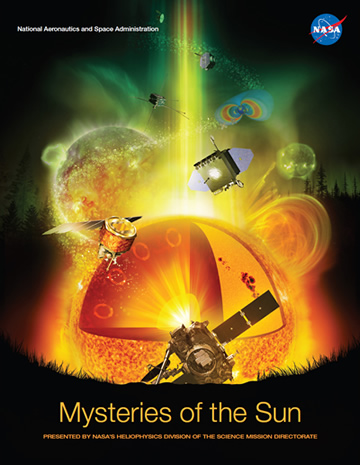April 16, 2012
New NASA videos explain "Mysteries of the Sun"

NASA has just released five new videos offering an engaging look at heliophysics, the study of the Sun's influence throughout the solar system and, in particular, its connection to the Earth and the Earth’s extended space environment—key areas of exploration for the Radiation Belt Storm Probes.
"Mysteries of the Sun” is a series of films that use award-winning graphics and animation, paired with clear and concise narration, to explore the science of our sun and how this star affects the solar system and Earth. Heliophysics researchers study the sun not only to better understand how it influences life, but also to study how it sends solar material out into space. The sun can also affect modern technology here on Earth: solar storms can affect our communications satellites and cause surges in power lines.
The five movies, available online at http://missionscience.nasa.gov/sun/ and on DVD, cover five areas of heliophysics: Space Weather, Solar Variability, the Heliosphere, Earth's magnetosphere, and Earth's upper atmosphere. A “Mysteries of the Sun” book is also available for free download as a PDF.
The “Mysteries of the Sun” movies:
Space Weather
This video describes the direct and dramatic effects that eruptions on the sun can cause at Earth. Earth's magnetic fields change shape and strength in response to an eruption on the sun, and these changes in turn can damage space born technology and disrupt communications traveling through space. They also cause aurora.
Solar Variability
Rotations of the material deep inside the sun cause constantly shifting magnetic field lines. This variability drives the solar cycle, during which the north and south magnetic poles reverse position approximately every 11 years.
The Heliosphere
The solar wind streams out from the sun until it collides with material from the rest of space. This entire bubble defined by the solar wind is called the heliosphere and scientists study the very boundaries to better understand our place in space.
Earth's Magnetosphere
Earth is enveloped in a protective magnetic envelope called the magnetosphere. This can change shape in response to the sun's effects, causing various types of space weather at Earth.
Earth's Upper Atmosphere
Certain layers, high up in the atmosphere also respond to incoming energy from the sun. These layers contain charged particles and so naturally respond to an influx of magnetic energy. Understanding such variability is crucial since it can, in turn, degrade radio communication as well as satellite orbits.
-Adapted from an article by Karen C. Fox, Goddard Space Flight Center |


